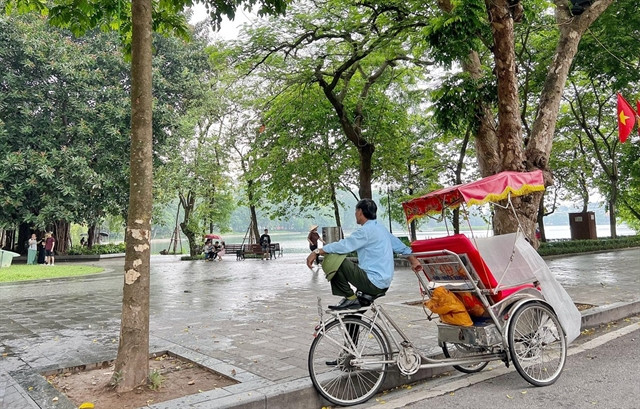 |
| Cyclo drivers, who run a popular tourist activity in Hà Nội, see few or no customers on rainy days. — VNA/VNS Photo |
Lan, owner of a bún chả (noodles with grilled pork) stall near the Temple of Literature in the capital city was among numerous small businesses caught in the current economic downturn.
“Before the pandemic, just one 45-seat tourist bus needed to stop by and I could sell out my stock for the entire day.
“Now there are only a few walk-in customers every now and then, we’re lucky if we don’t have any leftovers. It’s hard to do anything these days,” Lan told Vietnamplus.vn.
Hải Yến, a nearby teashop owner in the same situation said: “We barely made it through the pandemic. Back then there was no customer and I still had to pay VNĐ60 million (US$2,500) of rent each month.”
Yến made a big decision to move her shop from a small alley to the street front, as more than 90 per cent of her customers were foreign tourists, who were not only enjoying tea but also attending workshops on Vietnamese tea culture.
But then the pandemic hit, and now the teashop caters to a modest number of four to five tables on a good day, Yến said.
Around Hà Nội, many small contributors to the tourism supply chain, such as cyclo drivers, are also facing uncertainty.
Each cyclo ride costs around VNĐ200,000 ($8.4), said Bình, one of the drivers.
“On lucky days when the weather is nice, I can do around five to seven trips, but there are days when I have nothing to do.
“It’s tough because I need money for food, rent and everything else,” said Bình.
Seasonal struggle
While small businesses in Hà Nội are going through hardship, their location in the major tourist destinations which can welcome visitors all year round is still an advantage. Other localities are not as fortunate.
According to Thanh Thảo, a homestay manager on Hải Tiến Beach in the north central Thanh Hóa Province for the last four years, tourism activities in the area are very seasonal, lasting only from around June to August.
She added: “This year, even in the peak period the number of customers was only about 70 per cent compared to the previous years.
“Places are more crowded on the weekend, but on weekdays the occupancy rate is extremely low. In July, there were mid-week days when dozens of rooms were empty.”
Unable to secure a steady income source from the homestay business, Thảo juggles multiple jobs on the side, including selling seafood and providing grocery and cooking services for homestay customers.
Out on Hải Tiến Beach, fisherman Cường helps out at his family’s drink stall when he doesn’t have to go out to the sea, as summer is not the right time for fishing.
Cường said: “Many people only come here to take pictures for around two to three hours, they don’t really want to stay longer to have a drink. Our business was really sluggish yesterday and the day before.”
The drink stall of Cường’s family makes roughly VNĐ300,000 ($12.7) a day even during the summer.
As the tourist season ends, Cường’s wife will has to close down the stall and help out at construction sites to make ends meet. — VNS